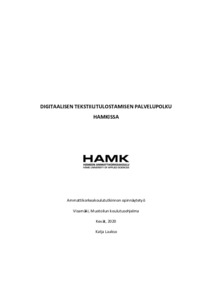Digitaalisen tekstiilitulostamisen palvelupolku HAMKissa
Laakso, Katja (2020)
Laakso, Katja
2020
All rights reserved. This publication is copyrighted. You may download, display and print it for Your own personal use. Commercial use is prohibited.
Julkaisun pysyvä osoite on
https://urn.fi/URN:NBN:fi:amk-2020051912293
https://urn.fi/URN:NBN:fi:amk-2020051912293
Tiivistelmä
Opinnäytetyön tarkoituksena oli laatia visuaalinen mallinnus HAMKin digitaalisen tekstiilitulostamisen palvelupolusta, yritysasiakkaan näkökulma huomioiden. Opinnäytetyön tilaajana toimi HAMK Oy, muotoilun koulutus.
Tällä hetkellä digitaalista tekstiilitulostusmahdollisuutta hyödynnetään koulutuksessa liian vähän, joka alleviivaa yritysasiakkaiden tarvetta tulostustoiminnassa, sillä laitteen edellyttämä käyttötiheys ei toteudu pelkästään opetukseen liitettyjen tulostustöiden myötä. Näin ollen digitaalisen tekstiilitulostamisen palveluntarjonta HAMKissa on välttämätöntä, joten selkeän palvelupolun ja sen kehityskohtien esille tuomisen tarve oli hyvin merkittävä.
Palvelunpolun rakenteen muodostamiseen ja asiakkaan näkökulman esilletuomiseen hyödynnettiin palvelumuotoilun menetelmiä, työkaluja sekä ihmiskeskeistä lähestymistapaa. Työn alkuvaiheessa koottu Miljoona kysymystä -lista sekä opinnäytetyön tekijän omat havainnot ja kerätty tieto HAMKin aiemmista tulostustoimeksiannoista tuottivat ymmärrystä asiakkaan tarpeesta sekä antoivat yksityiskohtaista informaatiota ja varsinaisen sisällön palvelupolkuun.
Työn tuloksena syntyi palvelupolkumallinnus, joka kertoo selväpiirteisesti tulostustoiminnan nykytilanteen. Mallinnuksen avulla saatiin esille palvelupolun kehityskohdat, joihin opinnäytetyön tilaajan tulee ehdottomasti löytää ratkaisuja. Työn tilaaja voi hyödyntää palvelupolun mallinnusta apuvälineenä palvelun kehittämistyössä. The purpose of this thesis was to create a visual service journey model of digital textile printing at HAMK from the business customer perspective. The commissioner of the thesis was HAMK Oy, design education.
At present the possibility of digital textile printing is underused in education, which emphasizes the need of business customers in printing operations, as the frequency of use required by the device is not realized only with the printing projects of students. Therefore, the providing of digital textile printing services at HAMK is essential, thus the need for a clear service journey and its development points to reveal was very significant.
The methods, the tools and the human-centered approach of service design were utilized to form the structure of the service journey and to present the customer's perspective. The Million Questions list compiled by the author and the observations and obtained information from the previous printing commissions at HAMK produced understanding of the customer's needs and provided detailed information and the actual content to the service journey.
The outcome of this thesis was the service journey model that shows the current state of the service. The commissioner of the work should find solutions to the development points that appeared in the model. The commissioner can utilize the model of the service journey as a tool in the service development.
Tällä hetkellä digitaalista tekstiilitulostusmahdollisuutta hyödynnetään koulutuksessa liian vähän, joka alleviivaa yritysasiakkaiden tarvetta tulostustoiminnassa, sillä laitteen edellyttämä käyttötiheys ei toteudu pelkästään opetukseen liitettyjen tulostustöiden myötä. Näin ollen digitaalisen tekstiilitulostamisen palveluntarjonta HAMKissa on välttämätöntä, joten selkeän palvelupolun ja sen kehityskohtien esille tuomisen tarve oli hyvin merkittävä.
Palvelunpolun rakenteen muodostamiseen ja asiakkaan näkökulman esilletuomiseen hyödynnettiin palvelumuotoilun menetelmiä, työkaluja sekä ihmiskeskeistä lähestymistapaa. Työn alkuvaiheessa koottu Miljoona kysymystä -lista sekä opinnäytetyön tekijän omat havainnot ja kerätty tieto HAMKin aiemmista tulostustoimeksiannoista tuottivat ymmärrystä asiakkaan tarpeesta sekä antoivat yksityiskohtaista informaatiota ja varsinaisen sisällön palvelupolkuun.
Työn tuloksena syntyi palvelupolkumallinnus, joka kertoo selväpiirteisesti tulostustoiminnan nykytilanteen. Mallinnuksen avulla saatiin esille palvelupolun kehityskohdat, joihin opinnäytetyön tilaajan tulee ehdottomasti löytää ratkaisuja. Työn tilaaja voi hyödyntää palvelupolun mallinnusta apuvälineenä palvelun kehittämistyössä.
At present the possibility of digital textile printing is underused in education, which emphasizes the need of business customers in printing operations, as the frequency of use required by the device is not realized only with the printing projects of students. Therefore, the providing of digital textile printing services at HAMK is essential, thus the need for a clear service journey and its development points to reveal was very significant.
The methods, the tools and the human-centered approach of service design were utilized to form the structure of the service journey and to present the customer's perspective. The Million Questions list compiled by the author and the observations and obtained information from the previous printing commissions at HAMK produced understanding of the customer's needs and provided detailed information and the actual content to the service journey.
The outcome of this thesis was the service journey model that shows the current state of the service. The commissioner of the work should find solutions to the development points that appeared in the model. The commissioner can utilize the model of the service journey as a tool in the service development.
